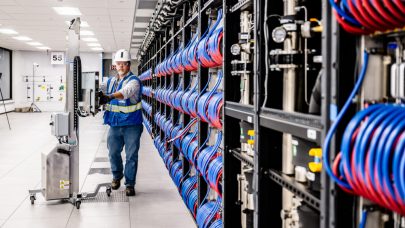
Argonne Places Aurora’s “Golden Blade” as Much Awaited Supercomputer Gathers Steam
July 24, 2023
While not a golden HPC spike, the final blade has been loaded into Aurora. As mentioned previously, final preparation of Aurora is underway. Aurora the "almost Read more…
Cerebras Has Big Plans for Big AI Chips: Build Your Own Cloud
July 20, 2023
Hyping an AI chip is one thing, but proving its usability in the commercial market is a bigger challenge. Some AI chip companies -- which are still prov Read more…

Aurora’s 10,624 Blades in Place as Exascale System Nears Completion
June 22, 2023
Aurora, one of the first three U.S. exascale supercomputers, has not had a straightforward path to installation and operation. The system has been repeatedly re Read more…

Meet TempoQuest, a Startup Bringing Weather Code Into the Accelerated Era
April 18, 2023
Weather and climate applications are some of the most important for high-performance computing, often serving as raisons d'être and flagship workloads for the Read more…

Theta Supercomputer Powers Bioenergy Research
March 2, 2023
Researchers have been working for many decades to convert abundant, renewable biomass – e.g. crops and algae – into viable alternatives to nonrenewable, dir Read more…

Electric Utility Leverages Argonne Supercomputing for Climate Planning
January 19, 2023
Traditional utility planning based on more or less stable seasons year-over-year isn’t cutting it any more – and supercomputing is key to helping utilities Read more…

Gordon Bell Special Prize Goes to LLM-Based Covid Variant Prediction
November 17, 2022
For three years running, ACM has awarded not only its long-standing Gordon Bell Prize (read more about this year’s winner here!) but also its Gordon Bell Spec Read more…

Gordon Bell Nominee Used LLMs, HPC, Cerebras CS-2 to Predict Covid Variants
November 17, 2022
Large language models (LLMs) have taken the tech world by storm over the past couple of years, dominating headlines with their ability to generate convincing hu Read more…

- Click Here for More Headlines

Whitepaper
Transforming Industrial and Automotive Manufacturing
In this era, expansion in digital infrastructure capacity is inevitable. Parallel to this, climate change consciousness is also rising, making sustainability a mandatory part of the organization’s functioning. As computing workloads such as AI and HPC continue to surge, so does the energy consumption, posing environmental woes. IT departments within organizations have a crucial role in combating this challenge. They can significantly drive sustainable practices by influencing newer technologies and process adoption that aid in mitigating the effects of climate change.
While buying more sustainable IT solutions is an option, partnering with IT solutions providers, such and Lenovo and Intel, who are committed to sustainability and aiding customers in executing sustainability strategies is likely to be more impactful.
Learn how Lenovo and Intel, through their partnership, are strongly positioned to address this need with their innovations driving energy efficiency and environmental stewardship.
Download Now
Sponsored by Lenovo
Whitepaper
How Direct Liquid Cooling Improves Data Center Energy Efficiency
Data centers are experiencing increasing power consumption, space constraints and cooling demands due to the unprecedented computing power required by today’s chips and servers. HVAC cooling systems consume approximately 40% of a data center’s electricity. These systems traditionally use air conditioning, air handling and fans to cool the data center facility and IT equipment, ultimately resulting in high energy consumption and high carbon emissions. Data centers are moving to direct liquid cooled (DLC) systems to improve cooling efficiency thus lowering their PUE, operating expenses (OPEX) and carbon footprint.
This paper describes how CoolIT Systems (CoolIT) meets the need for improved energy efficiency in data centers and includes case studies that show how CoolIT’s DLC solutions improve energy efficiency, increase rack density, lower OPEX, and enable sustainability programs. CoolIT is the global market and innovation leader in scalable DLC solutions for the world’s most demanding computing environments. CoolIT’s end-to-end solutions meet the rising demand in cooling and the rising demand for energy efficiency.
Download Now
Sponsored by CoolIT
Advanced Scale Career Development & Workforce Enhancement Center
Featured Advanced Scale Jobs:
HPCwire Resource Library
HPCwire Product Showcase
© 2024 HPCwire. All Rights Reserved. A Tabor Communications Publication
HPCwire is a registered trademark of Tabor Communications, Inc. Use of this site is governed by our Terms of Use and Privacy Policy.
Reproduction in whole or in part in any form or medium without express written permission of Tabor Communications, Inc. is prohibited.
























